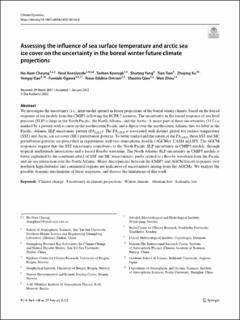| dc.contributor.author | Cheung, Ho-Nam | |
| dc.contributor.author | Keenlyside, Noel Sebastian | |
| dc.contributor.author | Koenigk, Torben | |
| dc.contributor.author | Yang, Shuting | |
| dc.contributor.author | Tian, Tian | |
| dc.contributor.author | Xu, Zhiqing | |
| dc.contributor.author | Gao, Yongqi | |
| dc.contributor.author | Ogawa, Fumiaki | |
| dc.contributor.author | Omrani, Nour-Eddine | |
| dc.contributor.author | Qiao, Shaobo | |
| dc.contributor.author | Zhou, Wen | |
| dc.date.accessioned | 2022-06-08T11:47:18Z | |
| dc.date.available | 2022-06-08T11:47:18Z | |
| dc.date.created | 2022-01-26T00:50:52Z | |
| dc.date.issued | 2022 | |
| dc.identifier.issn | 0930-7575 | |
| dc.identifier.uri | https://hdl.handle.net/11250/2997903 | |
| dc.description.abstract | We investigate the uncertainty (i.e., inter-model spread) in future projections of the boreal winter climate, based on the forced response of ten models from the CMIP5 following the RCP8.5 scenario. The uncertainty in the forced response of sea level pressure (SLP) is large in the North Pacific, the North Atlantic, and the Arctic. A major part of these uncertainties (31%) is marked by a pattern with a center in the northeastern Pacific and a dipole over the northeastern Atlantic that we label as the Pacific–Atlantic SLP uncertainty pattern (PA∆SLP). The PA∆SLP is associated with distinct global sea surface temperature (SST) and Arctic sea ice cover (SIC) perturbation patterns. To better understand the nature of the PA∆SLP, these SST and SIC perturbation patterns are prescribed in experiments with two atmospheric models (AGCMs): CAM4 and IFS. The AGCM responses suggest that the SST uncertainty contributes to the North Pacific SLP uncertainty in CMIP5 models, through tropical–midlatitude interactions and a forced Rossby wavetrain. The North Atlantic SLP uncertainty in CMIP5 models is better explained by the combined effect of SST and SIC uncertainties, partly related to a Rossby wavetrain from the Pacific and air-sea interaction over the North Atlantic. Major discrepancies between the CMIP5 and AGCM forced responses over northern high-latitudes and continental regions are indicative of uncertainties arising from the AGCMs. We analyze the possible dynamic mechanisms of these responses, and discuss the limitations of this work. | en_US |
| dc.language.iso | eng | en_US |
| dc.publisher | Springer | en_US |
| dc.rights | Navngivelse 4.0 Internasjonal | * |
| dc.rights.uri | http://creativecommons.org/licenses/by/4.0/deed.no | * |
| dc.title | Assessing the influence of sea surface temperature and arctic sea ice cover on the uncertainty in the boreal winter future climate projections | en_US |
| dc.type | Journal article | en_US |
| dc.type | Peer reviewed | en_US |
| dc.description.version | publishedVersion | en_US |
| dc.rights.holder | Copyright 2022 The Author(s) | en_US |
| cristin.ispublished | true | |
| cristin.fulltext | original | |
| cristin.qualitycode | 2 | |
| dc.identifier.doi | 10.1007/s00382-022-06136-0 | |
| dc.identifier.cristin | 1990009 | |
| dc.source.journal | Climate Dynamics | en_US |
| dc.relation.project | Nordforsk: 90077 | en_US |
| dc.relation.project | Norges forskningsråd: 316618 | en_US |
| dc.relation.project | Nordforsk: 76654 | en_US |
| dc.relation.project | Norges forskningsråd: 312017 | en_US |
| dc.relation.project | Trond Mohn stiftelse: BFS2018TMT01 | en_US |
| dc.relation.project | Notur/NorStore: NS9015K | en_US |
| dc.relation.project | Notur/NorStore: NS9064K | en_US |
| dc.relation.project | Notur/NorStore: NN9390K | en_US |
| dc.relation.project | Notur/NorStore: NN2343K | en_US |
| dc.identifier.citation | Climate Dynamics. 2022. | en_US |

